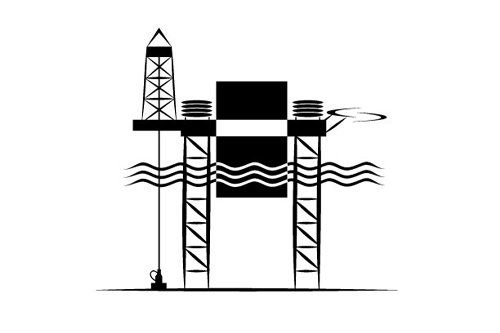
Drilling (Mobile Drilling Units)
Drillships (Moored Vessels)
1999
Early drillships were moored on location using 4 to 8 mooring lines leading to anchors or preset buoys. In 1963, the industry developed a design which permitted the drillship to rotate 360 degrees around an integral turret so it could always head into the seas thus reducing rolling motion.
The evolution of moored drillships follows:
- 1956, Submarex, CUSS Group, California, Over-the-side coring rig
- 1956, Wn. Explorer, Standard Oil, California, Center mounted coring rig
- 1956, CUSS I, CUSS Group, California, Full oilwell capability with center moon pool
- 1957, D-1, The Offshore Co., Gulf of Paria, 1st oil discovery from a floating vessel
- 1959, NOLA 1, NOLA 2, NOLA 3, Zapata Offshore, Gulf of Mexico, Converted YF Barges with over-the-side cantilever rigs
- 1962, Glomar II, Global Marine Inc., Cook Inlet, 1st new construction purpose-built drillship
- 1962, C. P. Baker, Reading & Bates, Gulf of Mexico, Catamaran formed by joining two YF hulls
- 1963, Discoverer I, The Offshore Co., Gulf of Mexico, 1st center turret mooring system
Recognizing the pioneering efforts of the following people and companies who contributed to the development of this technology:
CUSS Group [Continental Oil Co. (Conoco), Union Oil Co. (Unocal), The Superior Oil Co. (ExxonMobil) and Shell Oil Co. - Robert Bauer and A. J. Field.
Global Marine Inc. (GlobalSantaFe) - John R. Graham.
The Offshore Company (Transocean Inc.) - F. "Tim" Pease, George T. Richardson, George M. Savage, and Joe Scruggs.
Reading & Bates (Transocean Inc.) - George Temple
Standard Oil of California (ChevronTexaco) - Glen Schurman and Ken Nicholsen
Zapata Offshore Co. (Diamond Offshore) - George H. W. Bush
First & Second Generation Semi Submersible Drilling Rigs
2000
Deepwater drilling dictates that operations be carried out from a floating vessel. Drillships heave, pitch and yaw with each passing wave, and the industry needed more stable drilling platforms. A semi-submersible obtains its buoyancy from ballasted, watertight, pontoons located below the ocean surface and wave action. The operating deck is located above the tops of the passing waves. Structural columns connect the pontoons and operating deck. When the rig moves its location, the pontoons are de-ballasted so that the rig can float on the ocean surface.
In 1961, Shell Oil successfully converted an existing submersible rig into the first semi-submersible drilling unit for operation in the Gulf of Mexico. The industry quickly accepted the semi concept and the fleet increased rapidly to 30 units by 1972. At present, there are about 160 semi submersibles in service. First generation semis are generally limited to water depths of less than 600 feet, and second generation are usually intended for water depths up to 1000 feet. Most of these early semis have been retired.
- 1961, Bluewater I, First semi-submersible, converted from existing 4 column submersible, Shell Oil, 1 built.
- 1963, Ocean Driller, First new build; 3 col. Vee shaped structure, ODECO, 2 built.
- 1965, Sedco 135, 3 footed columns; arranged in a triangular shape, Friede & Goldman, 12 built.
- 1969, Pentagone 81, 5 footed columns arranged in pentagon shape, Neptune, 11 built.
- 1971, Ocean Prospector, First self-propelled, 12 columns; 2 main tubular hulls; Ocean Victory class, ODECO, 11 built.
- 1973, Sedco 700, Twin pontoon hulls; 8 columns thruster propulsion, Earl & Wright, 15 built.
- 1973, Western Pacesetter, Twin pontoon hulls; 6 columns, design licensed to all, Friede & Goldman, 39 built.
- 1974, Deap Sea Driller, Twin pontoon hulls, 8 columns (known as Aker H-3 Design), Aker Mek Verksted, 29 built.
Recognizing the pioneering efforts of the following people and companies who contributed to the development of this technology:
Bruce Collipp, Jerome Goldman, Alden J. "Doc" Laborde,
Bill Martinovich, Fred Olsen, Andre Rey-Grange,
Aker Mek Verksted,
Earl & Wright, a Sedco Company (Transocean Inc.),
Friede & Goldman (Friede Goldman Halter),
Neptune (Transocean Inc.),
ODECO (Diamond Offshore Drilling), Shell




